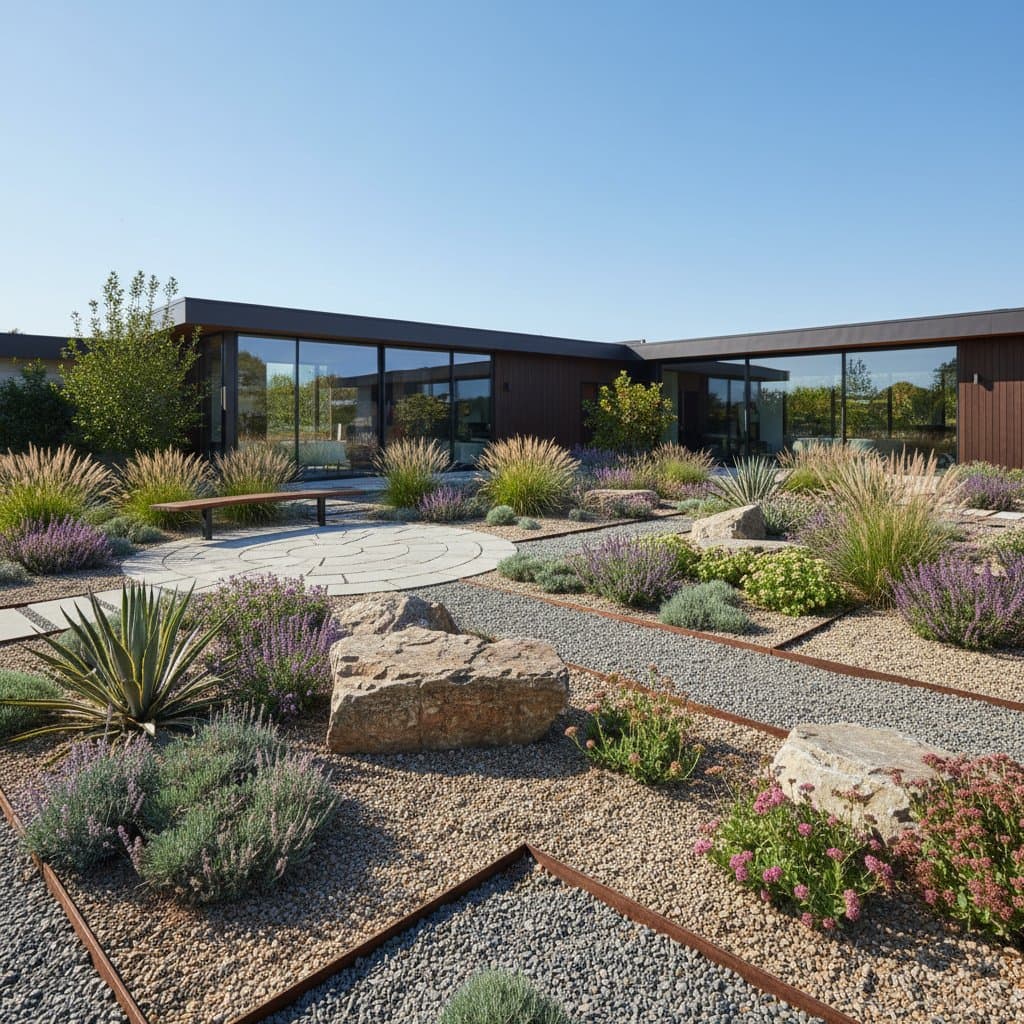Gravel Gardens: A Durable Alternative to Traditional Mulch
Landscape designer Eva Lin collaborated with homeowners Sam and Priya Patel to transform their front yard into a refined space that demands minimal effort. The couple sought a design that balanced visual appeal with practicality, given their demanding schedules. The resulting gravel garden combines textured elements, resilient plants, and efficient water management, creating an outdoor area that enhances their home without ongoing demands.
Why Gravel Gardens Are Gaining Popularity
Gravel gardens emerge as a practical choice for modern landscaping, particularly as homeowners prioritize sustainability and ease. These designs suppress weeds effectively, stabilize soil temperatures, and promote superior drainage compared to organic mulches. Unlike bark or wood-based options that break down over time, gravel retains its form and aesthetic integrity for years, eliminating the need for annual replenishment.
For the Patels, this longevity addressed a primary concern. Eva Lin explained, "The objective was to establish a surface that remains polished throughout the seasons, including periods of drought. Gravel delivers that consistent texture without requiring frequent interventions."
She opted for 3/8-inch crushed granite in a subtle gray hue. This particle size facilitates water infiltration while providing a stable surface for foot traffic. A slender steel edging delineates the gravel beds from an adjacent flagstone path, maintaining crisp boundaries.
Selecting Materials for Lasting Performance
The core of any gravel garden lies in thoughtful material selection. Eva Lin incorporated decomposed granite as the primary base, augmented with a modest amount of pea gravel for added dimension and traction. This combination compacts securely for safe navigation yet permits essential drainage.
Underneath, a geotextile fabric layer prevents weed intrusion without impeding water flow. Corten steel borders the edges, developing a patina that harmonizes with the gravel's tones and the surrounding greenery. For illumination, low-voltage LED lights embed along the pathway, accentuating the gravel's granular details after dark. These fixtures, constructed from powder-coated black aluminum, withstand environmental exposure effectively.
Homeowners can source these materials from local suppliers, ensuring compatibility with regional climates. Decomposed granite, for instance, suits arid areas by mimicking natural soil composition, while pea gravel adds subtle color variations that evolve with sunlight.
Designing Plantings for Resilience and Appeal
Effective gravel gardens hinge on plants that endure harsh conditions while contributing dynamic visuals. Selections should favor species adapted to full sun, elevated temperatures, and infrequent irrigation. Eva Lin organized plantings into cohesive groups based on form and texture, fostering a sense of harmony across the space.
Recommended Plant Species
- Blue fescue: Provides delicate, feathery texture in low, rounded mounds that require no staking.
- Catmint: Delivers prolonged flowering and attracts pollinators, enhancing biodiversity.
- Russian sage: Introduces vertical elements and gentle sway in breezes for added motion.
- Lavender: Offers aromatic foliage and persistent structure through winter.
- Sedum varieties: Serve as versatile ground covers with shifting seasonal hues.
- Agave: Supplies bold, sculptural forms for focal points.
- Mediterranean herbs (such as rosemary and thyme): Provide culinary utility alongside fragrant accents.
These choices thrive in the dry, permeable environment gravel creates. Establishment involves initial deep watering to encourage root development, followed by supplemental irrigation every two to three weeks during peak heat. The gravel layer conserves soil moisture by reducing evaporation rates significantly.
Installation Steps for a Professional Gravel Garden
Creating a gravel garden begins with site preparation. Clear existing vegetation and level the soil to a depth of four to six inches. Install the geotextile fabric securely, overlapping seams to eliminate gaps.
Next, introduce the gravel mix in layers of two inches, compacting each for stability. Position plants according to the design plan, ensuring adequate spacing for maturation. Finally, add edging and lighting to complete the framework.
This process typically spans one to two days for a modest yard, with costs ranging from $5 to $15 per square foot depending on material quality. Professional installation ensures precision, but DIY enthusiasts can achieve comparable results with basic tools like a rake and tamper.
Maintenance Essentials for Long-Term Success
Gravel gardens demand far less attention than mulched landscapes. Annual tasks include a light raking to redistribute gravel and remove debris, alongside occasional weeding around plant bases. Pruning focuses on spent blooms or leggy growth, performed in early spring.
Monitor for erosion in high-rain areas by replenishing gravel sparingly. Plants generally self-regulate, with division needed every three to five years for vigorous spreaders like catmint. This routine preserves the garden's structure while allowing natural evolution.
Embracing the Benefits of Gravel in Everyday Life
Several months post-installation, the Patels report a profound shift in their outdoor habits. They frequently relax on a nearby bench, observing the subtle play of light on the gravel and the activity of pollinators among the blooms. The space conveys vitality without disorder, offering a structured yet inviting retreat.
Gravel gardens excel in versatility, adapting to contemporary minimalist styles or classic cottage motifs. They conserve water, particularly in drought-prone regions, and withstand foot traffic better than softer mulches. For those aiming to streamline yard care while elevating curb appeal, this approach delivers enduring value.
Eva Lin captures the essence: "Gravel empowers you with intentional design and liberated enjoyment. Establish the framework, and let the ecosystem flourish independently."
The Patels echo this sentiment. Their garden now embodies equilibrium: composed yet serene, robust yet adaptable, seamlessly integrating into their routine.

